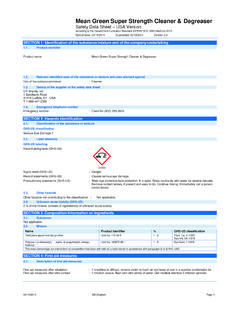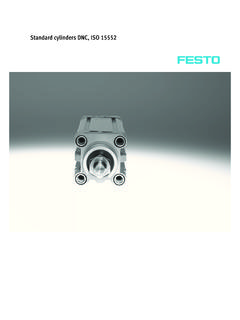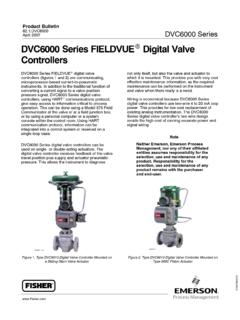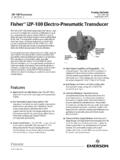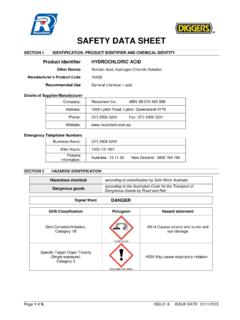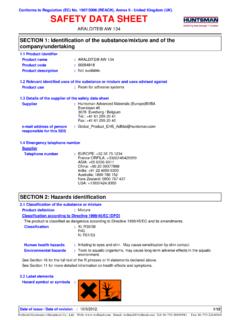Transcription of Stadis (R) 450 - Scie Chimiche (Chemtrails)
1 SAFETY DATA SHEET. Stadis (R) 450. 1. Identification of the substance/preparation and company/undertaking Identification of the substance or preparation Product name : Stadis (R) 450. Product code : 10101. Use of the : Fuel additive. Anti-static agents. substance/preparation Company/undertaking identification Supplier : Innospec Limited Innospec Manufacturing Park Oil Sites Road Ellesmere Port Cheshire CH65 4EY. United Kingdom Telephone no. : +44 (0)151 355 3611. Fax no. : +44 (0)151 356 2349. Emergency telephone number : +44 (0)151 355 3611. of the company See section 16. 2. Composition/information on ingredients Substance/preparation : Preparation Ingredient name CAS % EC number Classification number toluene 108-88-3 30 - 60 203-625-9 F; R11.
2 Repr. Cat. 3; R63. Xn; R48/20, R65. Xi; R38. R67. solvent naphtha (petroleum), heavy aromatic. 64742-94-5 - 30 265-198-5 Xn; R65. R66. N; R51/53. naphthalenesulfonic acid, dinonyl- 25322-17-2 - 246-841-9 Xi; R38, R41. propan-2-ol 67-63-0 - 200-661-7 F; R11. Xi; R36. R67. naphthalene 91-20-3 - 202-049-5 Carc. Cat. 3; R40. Xn; R22. N; R50/53. 1,2,4-trimethylbenzene 95-63-6 - 202-436-9 R10. Xn; R20. Xi; R36/37/38. Conforms to EU Directive 91/155/EEC, as amended by 2001/58/EC - United Kingdom (UK). Date of issue : November 30, 2006 Page: 1/10. Stadis (R) 450 Page: 2/10. 2. Composition/information on ingredients N; R51/53. methanol 67-56-1 - 200-659-6 F; R11. T; R23/24/25, R39/23/24/25. See section 16 for the full text of the R-phrases declared above Occupational exposure limits, if available, are listed in section 8.
3 3. Hazards identification The preparation is classified as dangerous according to Directive 1999/45/EC and its amendments. Classification : F; R11. Repr. Cat. 3; R63. Xn; R48/20, R65. Xi; R41. R66, R67. R52/53. Physical/chemical hazards : Highly flammable. Human health hazards : Risk of serious damage to eyes. Harmful: danger of serious damage to health by prolonged exposure through inhalation. Possible risk of harm to the unborn child. Harmful: may cause lung damage if swallowed. Repeated exposure may cause skin dryness or cracking. Vapours may cause drowsiness and dizziness. Environmental hazards : Harmful to aquatic organisms, may cause long-term adverse effects in the aquatic environment. See section 11 for more detailed information on health effects and symptoms.
4 4. First-aid measures First-aid measures Inhalation : Move exposed person to fresh air. If it is suspected that fumes are still present, the rescuer should wear an appropriate mask or self-contained breathing apparatus. Keep person warm and at rest. If not breathing, if breathing is irregular or if respiratory arrest occurs, provide artificial respiration or oxygen by trained personnel. It may be dangerous to the person providing aid to give mouth-to-mouth resuscitation. Get medical attention. If unconscious, place in recovery position and get medical attention immediately. Maintain an open airway. Loosen tight clothing such as a collar, tie, belt or waistband. Ingestion : Wash out mouth with water. Remove dentures if any. Move exposed person to fresh air.
5 Keep person warm and at rest. If material has been swallowed and the exposed person is conscious, give small quantities of water to drink. Stop if the exposed person feels sick as vomiting may be dangerous. Aspiration hazard if swallowed. Can enter lungs and cause damage. Do not induce vomiting unless directed to do so by medical personnel. If vomiting occurs, the head should be kept low so that vomit does not enter the lungs. Get medical attention. Never give anything by mouth to an unconscious person. If unconscious, place in recovery position and get medical attention immediately. Maintain an open airway. Loosen tight clothing such as a collar, tie, belt or waistband. Skin contact : Wash skin thoroughly with soap and water or use recognised skin cleanser.
6 Get medical attention if irritation occurs. Remove contaminated clothing and shoes. Wash clothing before reuse. Clean shoes thoroughly before reuse. Eye contact : Get medical attention immediately. Immediately flush eyes with plenty of water for at least 15 minutes, occasionally lifting the upper and lower eyelids. Check for and remove any contact lenses. Chemical burns must be treated promptly by a physician. protection of first-aiders : No action shall be taken involving any personal risk or without suitable training. If it is suspected that fumes are still present, the rescuer should wear an appropriate mask or self-contained breathing apparatus. It may be dangerous to the person providing aid to give mouth-to-mouth resuscitation. See section 11 for more detailed information on health effects and symptoms.
7 Conforms to EU Directive 91/155/EEC, as amended by 2001/58/EC - United Kingdom (UK). Date of issue : November 30, 2006 Page: 2/10. Stadis (R) 450 Page: 3/10. 5. Fire-fighting measures Extinguishing media Suitable : Use dry chemical, CO2, water spray (fog) or foam. Not suitable : Do not use water jet. Special exposure hazards : Highly flammable liquid and vapour. Vapour may cause flash fire. Vapours may accumulate in low or confined areas or travel a considerable distance to a source of ignition and flash back. Runoff to sewer may create fire or explosion hazard. This material is harmful to aquatic organisms. Fire water contaminated with this material must be contained and prevented from being discharged to any waterway, sewer or drain. Hazardous thermal : These products are carbon oxides (CO, CO2), nitrogen oxides (NO, NO2 etc.)
8 , decomposition products sulphur oxides (SO2, SO3, etc.). Special protective : Fire-fighters should wear appropriate protective equipment and self-contained equipment for fire-fighters breathing apparatus (SCBA) with a full face-piece operated in positive pressure mode. 6. Accidental release measures Personal precautions : Immediately contact emergency personnel. Eliminate all ignition sources. Keep unnecessary personnel away. Use suitable protective equipment. Do not touch or walk through spilt material. Environmental precautions : Avoid dispersal of spilt material and runoff and contact with soil, waterways, drains and sewers. Methods for cleaning up : If emergency personnel are unavailable, contain spilt material. For small spills, add absorbent (soil may be used in the absence of other suitable materials) and use a non-sparking or explosion-proof means to transfer material to a sealable, appropriate container for disposal.
9 For large spills, dyke spilt material or otherwise contain material to ensure runoff does not reach a waterway. Place spilt material in an appropriate container for disposal. 7. Handling and storage Handling : Aspiration hazard if swallowed. Can enter lungs and cause damage. Do not ingest. If ingested, do not induce vomiting. Avoid contact with eyes. Keep container closed. Use only with adequate ventilation. Avoid breathing vapour or mist. Keep away from heat, sparks and flame. To avoid fire or explosion, dissipate static electricity during transfer by earthing and bonding containers and equipment before transferring material. Use explosion-proof electrical (ventilating, lighting and material handling). equipment. Avoid contact of spilt material and runoff with soil and surface waterways.
10 Wash thoroughly after handling. Storage : Store in a segregated and approved area. Keep container in a cool, well-ventilated area. Keep container tightly closed and sealed until ready for use. Avoid all possible sources of ignition (spark or flame). Packaging materials Recommended : Use original container. 8. Exposure controls/personal protection Ingredient name Occupational exposure limits toluene EH40-WEL (United Kingdom (UK), 1/2005). Skin STEL: 574 mg/m3 15 minute/minutes. STEL: 150 ppm 15 minute/minutes. TWA: 191 mg/m3 8 hour/hours. TWA: 50 ppm 8 hour/hours. solvent naphtha (petroleum), heavy aromatic. Innospec Inc. (Europe, 2006). TWA: 100 mg/m3 8 hour/hours. propan-2-ol EH40-WEL (United Kingdom (UK), 1/2005). STEL: 1250 mg/m3 15 minute/minutes.
